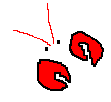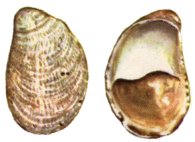Crepidula fornicata
Size: to 0.8 - 2 "
Habitat: attached to solid surfaces, often other larger shells
Notes:
Although the dead empty shells superficially resemble bivalves, Slipper Shells are actually extremely flattened snails. The living animal has only a single uncoiled shell, and lives under it attached to a hard surface. A small shelf inside gives these odd animals their name. The illustration shows the shell from above on the left and from below on the right. Slipper shells are quite commonly attached to the undersides of Sea Scallops, often in stacks. Filter feeders.
More: Slipper Shells ...



